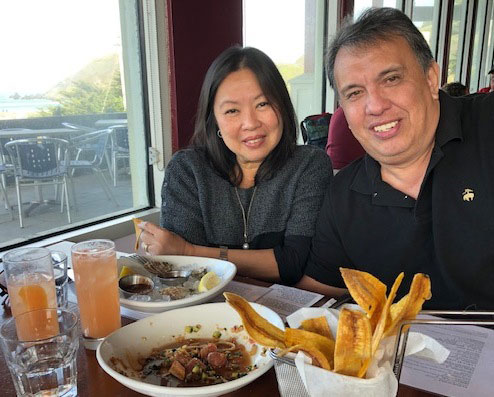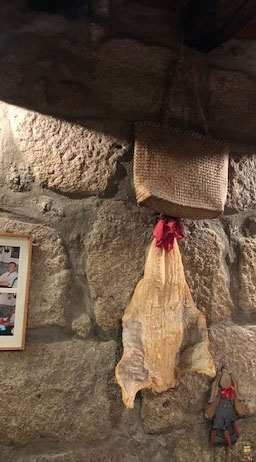Bacalao With Love
/Creative entrepreneurs Jackie and Raffy Caballero who serve up bacalao year round try ceviche in a Pacifica restaurant. (Photo by Cherie Querol Moreno)
It’s the European cousin of the Filipino “daing,” salted dried fish that finds its way on Philippine tables for a meal (especially with fried rice and egg), a side (counterpoint to the Bicol favorite “laing”), or snack (with a tall cold drink).
“Bacalao” in Spain, “baccala” in Italy, “bacalhau” in Portugal, the delicacy simply known as salt cod to Americans north of Tijuana sustained the vanguards of the Age of Exploration. Preserved indefinitely in salt and left to dry in the sun, it’s resurrected with soaking, rinsing out and replacing the briny bath water a few or several times, depending on the cook’s tolerance for the mineral.
The Portuguese like to say they have 365 ways to cook their bacalhau, one for each day of the year. Rehydrated, the now-fleshy slab may be fried or grilled, braised or boiled, chopped or shredded or whirred, and aromatized with Mediterranean herbs and spices.
Whole bacalao proudly displayed at a restaurant in Porto, Portugal.
Processed mostly from cod caught off Newfoundland in Canada or Lofoten, Norway, the preserved fish is reborn and enjoyed as far around the planet as Asia, where its price tag limits its consumption to the wealthy. Here in the San Francisco Bay Area, it's available for $10.99 a pound at La Loma Latino market. The Spanish Table sells 1-pound packs of skinless, boneless slabs for $17.99.
Former president and now Metro Manila Mayor Joseph Estrada is an avowed fan. But not Caballero, the then-gastronome-in-the-making, who could not comprehend the appeal of her family’s Christmas, Holy Week, Easter or birthday prandial masterpiece.
“Too salty,” she would verbally caption her crumbling face denoting the effect of the briny dish in her mouth. At 12, her attitude and palate were still evolving.
“Everything else about the bacalao of my childhood looked delicious,” Caballero recalls being seduced visually by the steaming garlicky stew of tomatoes, potatoes, onions and bell peppers heightened with pimenton (red pepper powder) and wine. But a bite of the intensely saline morsels swimming in the sauce assaulted her taste buds, driving her toward the less fanciful in her introduction to the culinary world.
If genes dictate taste, Caballero did inherit her chemist-farm owner father Hector Moreno’s fondness for rich dairy and her home economics grad-beauty queen mother Nena’s uncompromising standards. Butter elevates a simple sauté and tenderloin defines steak -- she quickly internalized the philosophy of her mother, who once managed Talk of The Town, the cafeteria at the Manila Doctors’ Hospital.
Five decades later, Caballero makes a casserole of bacalao that’s a top order at Eats Amore Foods, her and husband Raffy Caballero’s catering enterprise from their home in Merville, Parañaque.
Wine neutralizes the fishy brininess of salt cod. (Photo by Cherie Querol Moreno)
Their dream creative project did not exactly focus on food. Parents to four in the early 1990s, they chose self-employment and launched their home accessories manufactory they named Art of Gold. Their functional art -- hand-painted artisanal wares such as throw pillows, hand towels and sheets, trays, cachepots -- fly off the racks at bazaars in Manila and into the residences in gated villages.
“We make world-class products Filipinos can be proud to give as gifts to their friends abroad,” says Jackie, who shares all duties with Raffy, an unabashed gourmand who played for the Philippine national soccer team while in high school at La Salle Greenhills.
Running their own business allowed the couple to lunch at home and build clientele goodwill by hosting dinners from their busy kitchen.
Both self-taught, they consulted with relatives and friends who are successful entrepreneurs. Over dinner one night, friends from the financial sector suggested a new venture: Since the Caballeros love to cook and entertain, why not cater their office meetings with bankers?
The couple mulled over the proposal and took a bite, so to speak. The response confirmed Jackie’s unsung culinary chops. Orders started coming in for gourmet spreads for corporate meetings and private events at more bankers’ homes. Suddenly, she was in her mother’s apron, from the comfort and convenience of her own home, with a sous chef, a line cook and a deliverer completing her crew.
Last Christmas, Eats Amore served up 75 orders of Chicken Relleno and 35 platters of Beef Salpicao, their year-round bestsellers. Bacalao is in demand particularly at this time, Lent, reminding Jackie that with the right touch, everything is delectable.
Bacalao need not be offensive, Caballero says after learning from experimentation.
“You can soak and rinse as many times to desalinate the fish.” She figured out the process, with a caveat not to overdo the steps, which could rob the precious chunk of its character. “Don’t throw away your money with too much soaking and rinsing.”
Bacalao is definitely an acquired taste. Those raised on patis (garum in old Rome) or bagoong (anchovies) and alamang or nam prik (Philippine or Thai salted baby shrimp) should delight in the umami bomb.
Caballero adapted her version from the loaded recipe often served at her parents’ Horseshoe Village home. She took pointers from her father-in-law, Ramon Caballero, chef-owner of Ramon’s and Alla restaurants in Greenhills before moving to San Francisco in the 1980s.
Toward the end of her recent visit with her brother in Daly City, Jackie whipped up her former nemesis for his family’s meatless Fridays.
She declines to attribute her bacalao recipe to a particular country because her version, she claims, was born in her heart. And there’s no secret seasoning, she says between Mmmmm’s and Aaaaah’s, “except love.”
***
Full disclosure: Author is the sister-in-law and fellow foodie of Jackie Moreno Caballero.
For a recipe on Eats Amore’s Bacalao Casserole http://www.positivelyfilipino.com/magazine/the-happy-home-cook-bacalao-casserole
Cherie M. Querol Moreno is a Commissioner with the San Mateo County Commission on Aging and executive director of nonprofit ALLICE Alliance for Community Empowerment. She is editor at large of Philippine News, columnist for Philippines Today USA and contributor to Rappler and GMA News Online.
More articles from Cherie Querol Moreno





